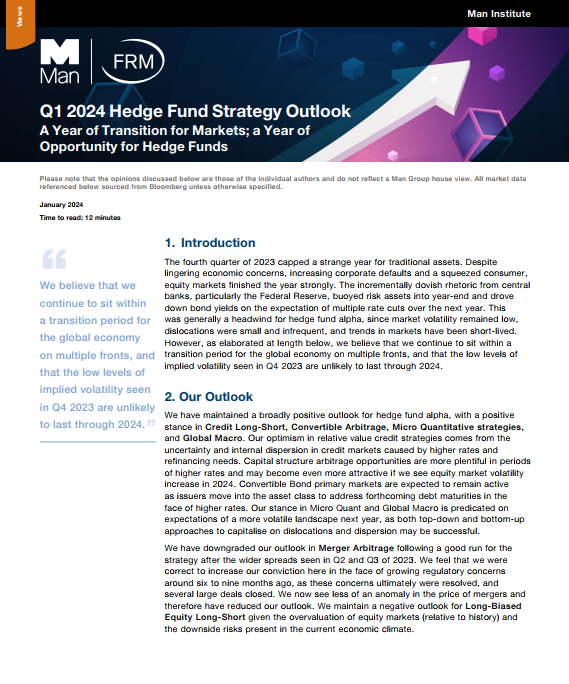
Write something
Sustainable finance works
Looks like I'll be the first to mention and highlight the value and power of Impact investing through the Thematic funds of ESG environmental social governance. As more and more funds, portfolios and asset managers look to diversify into responsible investing, the waters can be murky. However, with better data clarity and coordination with governance bodies, the path to sustainable finance is visible in the short sight. Resources: https://www.greenchoicefund.com/blog
0
0

Quantitative Strategies Notes by Goldman Sachs - Trading and Hedging Local Volatility
These note outline a methodology for hedging and trading index volatilities. Topics Covered :- - Implied and Local Volatilities - Analogy Between Local Volatilities and Forward Rates - Gadgets for Interest Rates - Hedging Against Forward Rate Changes - Hedging Local Volatilities - An Example Using Finite Volatility Gadgets
1
0

18/03/24 - DEUTSCHE BANK - Economic Outlook and Market Trends
- GDP GROWTH AND INFLATION EUROZONE In 2024, the Eurozone's GDP growth is expected to remain subdued at 0.7%, despite a modest tailwind from easing trends. Inflation, which averaged 5.5% in 2023, has been falling primarily due to lower energy prices. Core inflation stood at 3.1% in February 2024, with headline inflation expected to average 2.5% in 2024. Subdued economic activity and a tight labor market will contribute to the inflation outlook. JAPAN Japan achieved robust GDP growth of 1.9% in 2023, despite weak domestic demand and real consumption in the second half of the year. In the coming quarters, ongoing Shunto wage negotiations could result in significant wage hikes, contributing to a rise in private consumption and reinflationary tendencies. GDP growth is projected at 0.5% in 2024. Inflation, which averaged 3.2% in 2023, fell to 2.2% in January 2024. Core inflation fell to a 22-month low of 2.0%. Inflation is expected to continue easing, averaging 2.3% in 2024. UNITED STATES In 2023, headline consumer price inflation in the U.S. averaged 4.1%. It has eased in recent months to 3.2% in February 2024. Core inflation has been steadily trending down to 3.8% in February, but sequentially, it has risen over the past three months, suggesting that the next steps towards the 2% target rate will be challenging. Inflation is expected to average 2.8% throughout 2024. - CENTRAL BANK POLICIES AND INTEREST RATES EUROZONE The European Central Bank (ECB) is expected to deliver a first rate cut of 25 bps in June and two further rate cuts of the same magnitude over the rest of the year, as well as an additional cut in the first quarter of 2025. JAPAN The Bank of Japan (BoJ) is expected to end its negative interest rate policy (NIRP) in spring 2024, with the policy rate expected to be 0.25% at the end of the forecasting period. United States The Federal Reserve (Fed) is expected to lower its interest rates, with an initial 25 bps cut in June 2024, followed by two additional cuts by the end of the first quarter of 2025.
1
0

HEDGE FUND - 20/1/24 - Man Group - Q1 Strategy Outlook
SUMMARY The fourth quarter of 2023 was unusual for traditional assets, with equity markets finishing strong despite lingering economic concerns, increasing corporate defaults, and a squeezed consumer. Central banks, particularly the Federal Reserve, adopted an incrementally dovish rhetoric, which buoyed risk assets and drove down bond yields, expecting multiple rate cuts in the upcoming year. This, in turn, led to low levels of implied volatility, making it challenging for hedge funds to generate alpha. However, the authors believe that the global economy continues to undergo a transition period, and the low levels of implied volatility may not last through 2024. OUTLOOK AND STRATEGIES The authors maintain a broadly positive outlook for hedge fund alpha, favoring Credit Long-Short, Convertible Arbitrage, Micro Quantitative, and Global Macro strategies. The optimism in relative value credit strategies stems from the uncertainty and internal dispersion in credit markets due to higher rates and refinancing needs. Capital structure arbitrage opportunities are expected to be more attractive if equity market volatility increases in 2024. Convertible Bond primary markets are likely to remain active as issuers move into the asset class to address forthcoming debt maturities in the face of higher rates. The stance in Micro Quant and Global Macro strategies is based on expectations of a more volatile landscape next year, where both top-down and bottom-up approaches may be successful in capitalizing on dislocations and dispersion. On the other hand, the authors have downgraded their outlook for Merger Arbitrage following a good run in Q2 and Q3 of 2023. They now see less of an anomaly in the price of mergers and, therefore, have reduced their conviction. The outlook for Long-Biased Equity Long-Short remains negative due to the overvaluation of equity markets relative to history and the downside risks present in the current economic climate. CREDIT STRATEGIES In the credit space, the authors continue to hold a positive view on Credit Long-Short and a neutral view on Distressed. The prolonged period of relatively benign market conditions indicates that there is still more to do in relative value trades in Credit as opposed to restructuring opportunities. US High Yield spreads closed the year near their tightest levels since pre-2020, below historical median levels, which feels at odds with the growing level of defaults and poor recovery rates seen in the asset class over the last year. The authors suggest that this may be due to the increased appetite of investors to allocate to higher quality credits given the optical appeal of yields close to estimates of fair value. There is still a large universe of convertible bonds trading below 80% of par value, and of these, more than 40% have no other debt, making Convertible Bonds a lucrative source of alpha for idiosyncratic opportunities. Unlike traditional credit markets, spreads in high yield convertible bonds remain wide, providing an additional yield pick-up for managers with good stock selection skills.
3
0

CRYPTO - 21/1/24 - CoinShare - Outlook 2024
EXECUTIVE SUMMARY 2024 is set to be a landmark year for digital assets. The launch of spot-based Bitcoin ETFs in the US could potentially raise Bitcoin prices to approximately $60,000. Bitcoin’s value continues to be significantly influenced by monetary policy. With the US Federal Reserve likely to cut interest rates in the first half of 2024, Bitcoin, alongside gold, could see increased appeal due to their role as alternative stores of value. The diminishing appeal of the US Dollar amid geopolitical shifts and concerns over US debt sustainability could lead to a decreased appetite for the dollar and a corresponding improving interest in Bitcoin. The high correlation between bonds and equities is also driving investors towards Bitcoin for diversification, further influencing its adoption and valuation. Ethereum saw relatively muted institutional inflow in 2023, attributed to stiff competition from low transaction fee alt-L1 protocols like Solana and scepticism over its scaling roadmap set to take shape in H1 2024. A successful implementation with improving L2 user interaction mechanics, alongside the possibility of a Spot Ether ETF could rekindle inflows. Developer activity in most crypto ecosystems continues to fall from their peaks in January 2022. Exciting new developments and upgrades in major protocols could spark a resurgence in activity in 2024. REGULATORY DEVELPMENTS In 2024 the EU’s Markets in Crypto Assets Regulation will commence and more countries are expected to provide guidance for regulated stablecoins. The Bitcoin mining industry is preparing for the 2024 halving event, with miners in better shape compared to previous halvings. This event, coupled with regulatory advancements and monetary policy changes, could significantly influence Bitcoin’s price. BLOCKCHAIN EQUITIES AND MACROECONOMIC TRENDS The report analyzes the impact of the Federal Reserve’s shifting monetary policy, looming corporate debt maturity walls, and interest rate cuts on blockchain equities in 2024.
2
0

1-6 of 6

skool.com/baglini-finance-6899
A community on Quantitative Finance, Investments, Portfolio Management and much more.
powered by

